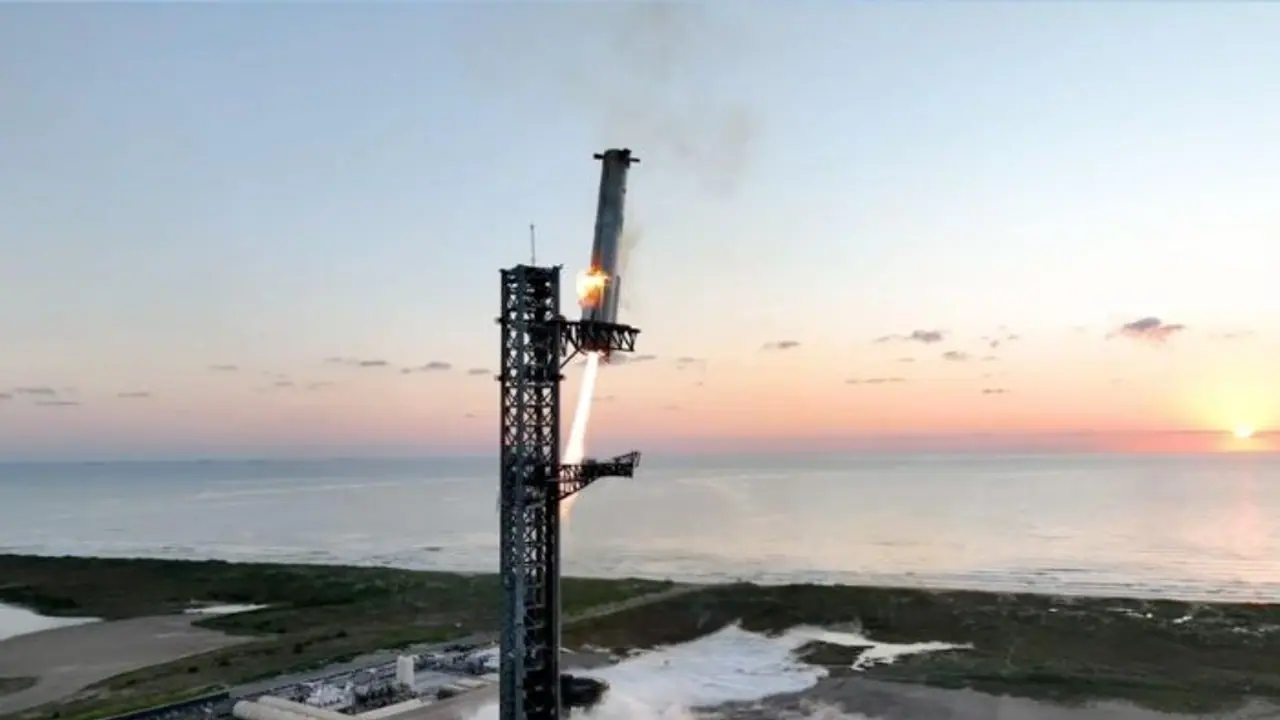SpaceX's fifth Starship test flight saw the Super Heavy booster successfully return to the launchpad using mechanical arms, marking a historic achievement in reusable rocket technology. This milestone brings SpaceX closer to reducing space travel costs and advancing Elon Musk's Mars colonization vision.
SpaceX accomplished an impressive engineering milestone on Sunday with its fifth test flight of the Starship rocket. In a groundbreaking move, the Super Heavy booster successfully returned to the launchpad after liftoff, marking the first time this has ever been done. This achievement shows that Elon Musk's SpaceX may have developed a launch system capable of changing how space exploration is carried out.

Soon after takeoff, the 233-foot Super Heavy booster separated from the Starship, which was positioned on top of it. The booster then returned to the launch site. As it came down towards the launchpad, two large mechanical arms, often called "chopsticks," caught it in a precise manoeuvre.
This groundbreaking achievement moves SpaceX closer to Elon Musk's vision of creating the first completely reusable rocket system. By doing so, the goal is to significantly reduce the cost of space travel and eventually enable humans to live on other planets.
About an hour later, the Starship returned to Earth, making a controlled landing in the Indian Ocean with its engines still running. However, it seemed to catch fire as it sank into the water. In the future, SpaceX plans to land the Starship safely on solid ground in one piece.
Now that SpaceX has successfully demonstrated that both the Starship and Super Heavy rockets can launch into space and safely return to Earth in one piece, the company is on course to lower the cost of rocket launches by an estimated 10 times.
Starship is built to be the first completely reusable rocket in the world. This means both the booster and the spaceship are designed to come back to Earth and be used again, without needing to be rebuilt.
The successful landing of Super Heavy on Sunday is one of the final major milestones in reaching this goal.
The cost benefits of reusability are real. SpaceX’s Falcon 9 boosters have already shown that reusing rockets can lower expenses. They can offer fast and affordable launches for around $67 million per flight, which works out to about $1,500 per pound of cargo.
In comparison, when the Space Shuttle was in operation, it cost roughly $25,000 to send each pound of cargo into space.
Elon Musk, the founder and CEO of SpaceX, has stated that his goal is to reduce the cost of Starship launches to around $10 million. This significant price drop could make futuristic space industries, such as asteroid mining and space-based factories, a reality. In the long run, it could help Musk achieve his dream of establishing a colony on Mars with a population of 1 million people.
Starship is the spacecraft designed to fulfil Musk's vision of reaching Mars.
"No rocket before could enable life on another planet," said Musk in April. He founded SpaceX in 2002 with this goal in mind. However, Musk is not alone in this ambition.
Olivier de Weck, a professor of aeronautics, astronautics, and engineering at MIT, previously told Business Insider that he strongly believes this will be the main spacecraft that takes humans back to the moon and even to Mars.
He explained that this isn’t just an impressive rocket project – it has the power to impact the future of humanity.
SpaceX Achieves Historic Rocket Milestone
In a scene that felt straight out of a sci-fi movie, the rocket smoothly lowered itself into the tower's mechanical arms while SpaceX employees celebrated with cheers.
This marked SpaceX’s first try at the groundbreaking "chopstick" manoeuvre. Engineers described the booster landing as "a moment for the history books."
This engineering achievement is unlike anything previously seen in orbital rocket technology, though Elon Musk has been talking about it for years.
"I know it sounds crazy," Musk said in a 2021 interview with the YouTube channel Everyday Astronaut. "When I first brought it up, people thought I was out of my mind."
"SpaceX's Dispute with the FAA"
SpaceX has experienced multiple setbacks and delays since Starship's first high-altitude flight 18 months ago. The company claims that regulators are holding up the fifth test launch due to small modifications and that the Federal Aviation Administration (FAA) is being slow in moving things forward.
However, on Saturday, the FAA gave the green light for Starship's fifth launch, and SpaceX quickly proceeded with the launch the following day. The FAA did ask SpaceX to take additional measures in the future to more thoroughly assess the environmental impact of their launches.
For instance, SpaceX will have environmental engineers examine how the launches impact nearby animal nesting areas, both during and after the launches, according to The New York Times.
(The author of this article is a Defence, Aerospace & Political Analyst based in Bengaluru. He is also the Director of ADD Engineering Components, India, Pvt. Ltd, a subsidiary of ADD Engineering GmbH, Germany. You can reach him at: girishlinganna@gmail.com)
